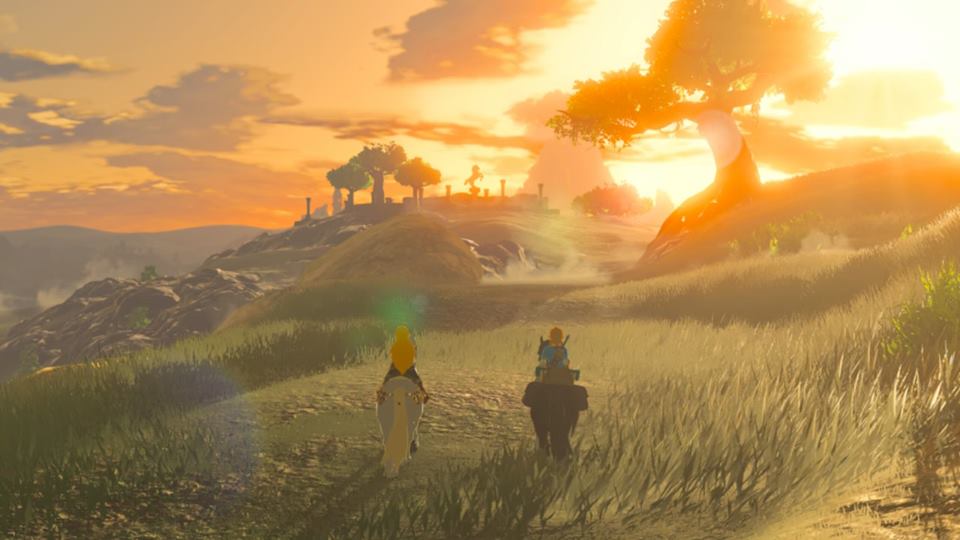
The Legend Of Zelda: Breath Of The Wild
Nintendo’s latest Zelda game is a bit like that famous shot in Hitchcock’s Vertigo, simultaneously moving forwards and backwards. It is ultimately oxymoronic: sprawling yet intimate, heroic yet quiet, maximalist yet minimalist, old yet new.
By looking back at the game that started it all in 1987, Nintendo were able to identify the essence of Zelda – in a word, adventure. From here they sprang forward with a game that is Zelda to the core, but with a sprinkling of modernisms from more recent games that Zelda has itself influenced over the years. The result is a richly detailed game that rinses every ounce of its adventure theme, but does so through incredibly polished, streamlined gameplay – for better and for worse.

The setting is typical Nintendo, putting a clever twist on the familiar. Taking place 100 years after a great calamity in which robots awakened to scar the land and kill many of its inhabitants, Breath of the Wild is essentially a post-apocalyptic game. Hero Link awakens with amnesia and must travel the world piecing together his memories to save the titular princess. Except this isn’t a world of scorched blackened earth, smoky skies and pervading dread. It’s a world of beauty and environmental storytelling, where flowers bloom over rolling verdant hills, wildlife rustles amongst the grass and trees, the sun bleeds vibrant warmth over tumbling stone ruins and everything glistens. It is, without doubt, the most visually stunning game ever released and an amazing artistic achievement – simply climb a hill, sit back and watch the world go by.
Yet it’s equally a world of melancholy and sparse simplicity. Much of that atmosphere derives from the minimalist soundtrack. For the most part it is, quite literally, the sound of the breath of the wild, silence broken only by fragments of piano chords and melody. It is the sound of a lone hero against a great oblivion, his mind empty of memory. Other orchestral touches add character to the overwhelming sadness with familiar melodies from previous games adding a light touch of nostalgia, all juxtaposed with a colourful world that demands to be saved.

It’s a world you explore freely with little direction. Quests are noted in your adventure log and protruding towers provide a focal point that unlocks each area of the map, but the screen is free from distracting icons and markers. There’s no obvious guide, forcing you to consider the lay of the land directly, pay attention to speeches from NPCs, and even listen to the soundtrack for guiding hints. It’s a game that makes you feel like an adventurer, that isn’t afraid to drop you in its centre and say, “off you go, explore”. And crucially, exploring the world is always incredibly enjoyable. Run off in any direction, climb any surface, complete quests in any order. This is your adventure, own it.
It makes for a very personal and liberating experience, but its one that does lack drama and urgency. The plot is told in small fragments as Link discovers his lost memories, but there’s very little to see. Where previous games in the series have offered intriguing twists and quirky characterisation, Breath of the Wild instead works in broad brushstrokes. It can leave you feeling lost and confused.

What’s gained is player agency. Story is not the priority here, instead you get out what you put in based on your own curiosity. It’s punctuated by big moments of grandeur, but for the most part it’s a game about small, intimate moments far too numerous to mention: moments of discovery, moments of beauty, moments of quiet contemplation. Stumbling across these yourself just makes them all the more memorable, meaningful and poignant. More than ever, you are the hero in your own adventure, not simply following the whims of a game designer.
Still, for old time fans Breath of the Wild does disappoint on some Zelda staples. There are only four main dungeons and while they’re each built around a clever mechanic, they remain small. That also means there’s only four bosses – each is frighteningly designed, but not the most memorable the series has seen.

Instead, most of the game’s puzzles and fighting takes place within the 120 shrines hidden across the land. Discovering these is an utter joy, with some hugely inventive puzzles that make clever use of Link’s powers as well as the unique capabilities of the Switch itself, all delivered in bite-sized pieces perfect for gaming on-the-go. Nevertheless, something is missing with the lack of uniquely intricate dungeons, these shrines eventually becoming visually repetitive.
Really, though, Breath of the Wild is a new kind of Zelda game that takes the idea of an open world game literally, its sheer scope and satisfaction out-weighing any narrative flaws. There’s a loose structure in place and gameplay is pinned down by smartly inter-linking systems (combat, cooking, weather, physics) within a vast land to explore. Only Nintendo would have the confidence to create such a carefully considered, intricate and detailed world and then pass power to the player; no game captures the whole notion of ‘adventure’ in such a thrilling, wonderful, yet quietly restrained way. In the game’s very opening, Link steps onto a precipice as the camera pulls out to offer a tantalising glimpse of the world, a delicious tease that sparks the imagination. Where will you go first? What might you encounter? And can you survive?
This article first appeared in The Gizzle Review







